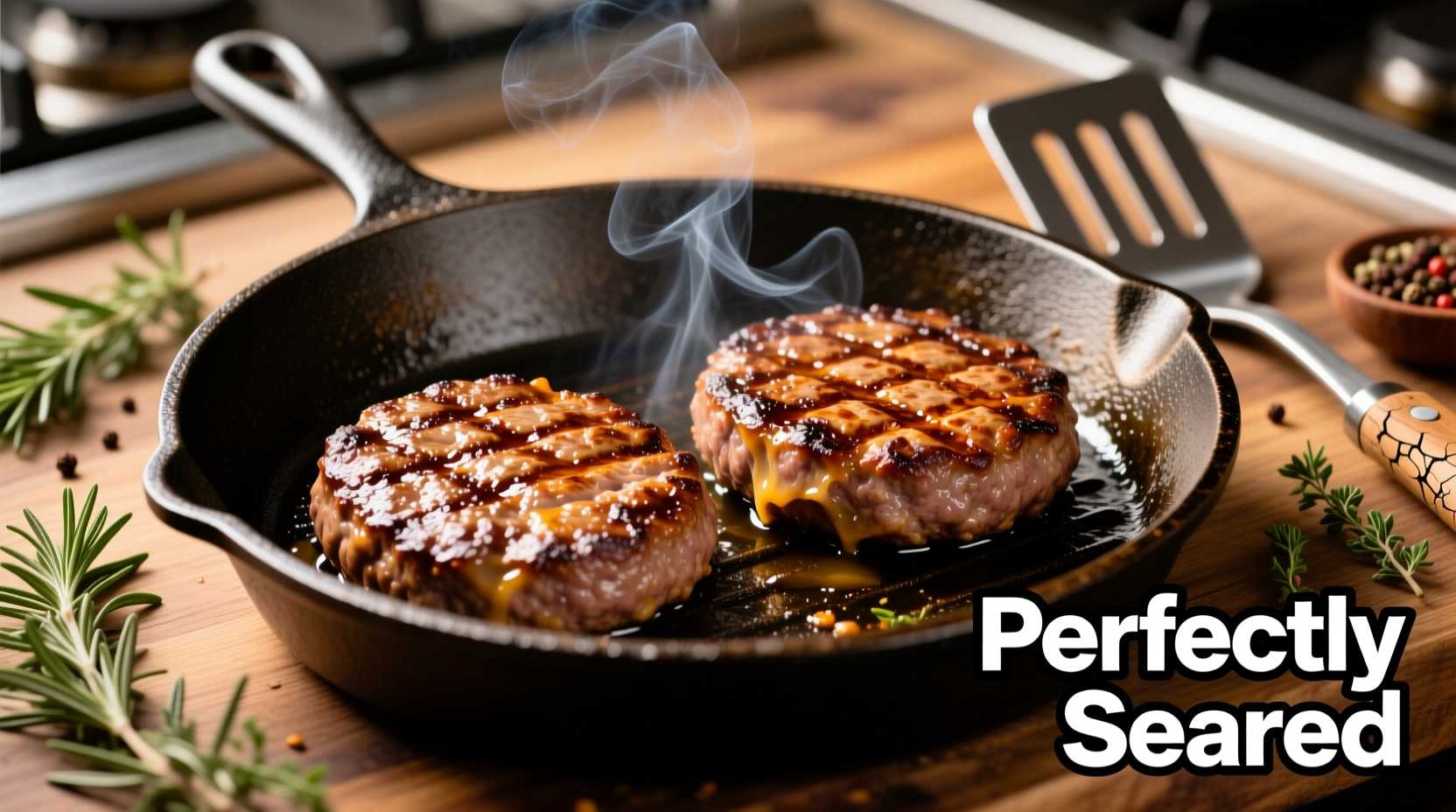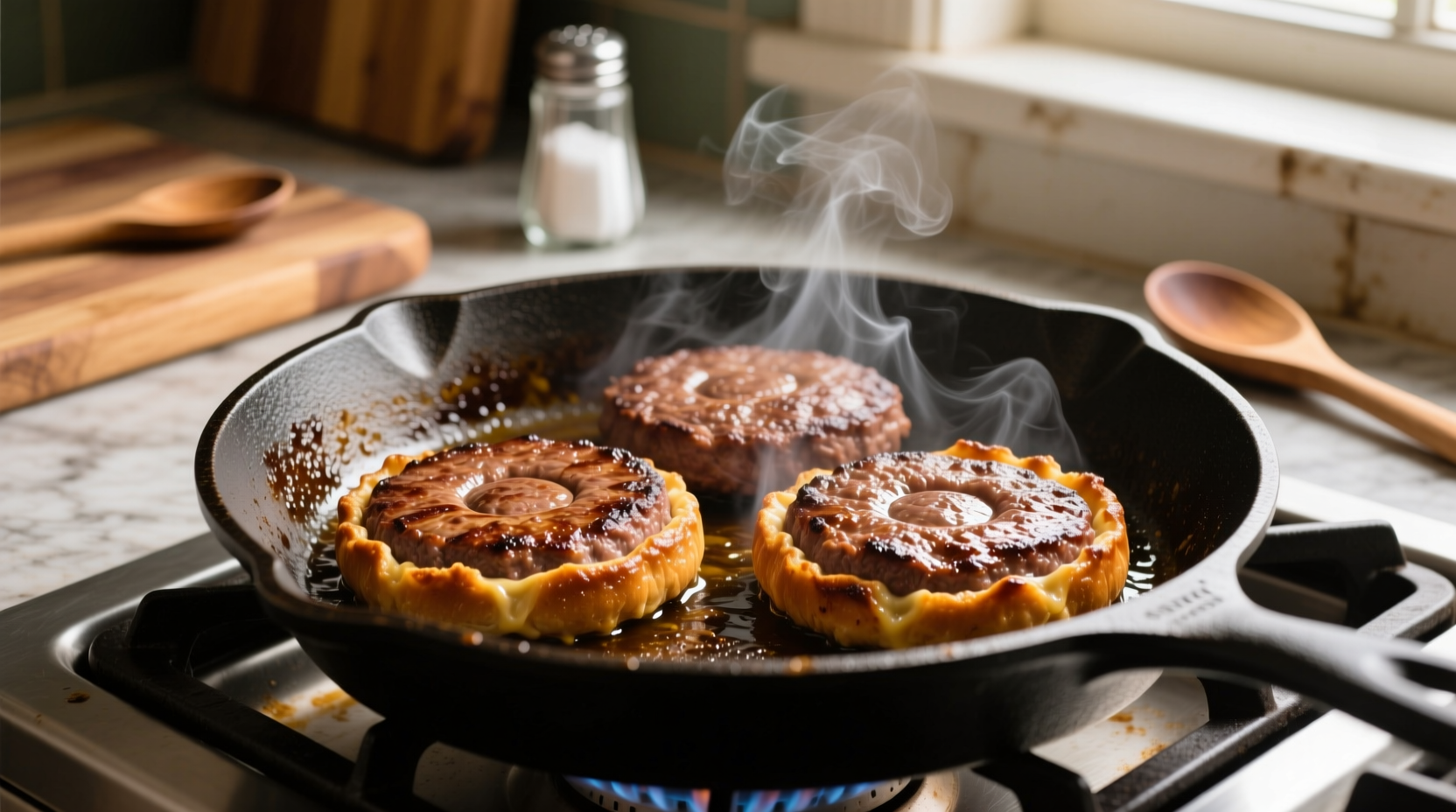Heat 1 tablespoon of oil in a skillet over medium-high heat until shimmering. Add 1 pound of 80% lean ground beef, breaking it into even pieces. Cook undisturbed for 3-4 minutes to develop a golden crust, then flip and cook to 160°F internal temperature (about 5-7 minutes total). Drain excess fat and season to taste.
Mastering the art of cooking hamburger meat in a pan transforms ordinary weeknight meals into restaurant-quality dishes. Whether you're preparing classic burgers, meat sauces, or hearty casseroles, proper pan-cooking technique ensures juicy, flavorful results every time. This guide reveals professional methods that guarantee perfect browning while maintaining food safety standards.
Essential Tools and Ingredients for Success
Before you start cooking, gather these kitchen essentials. Using the right equipment makes a dramatic difference in your hamburger meat's texture and flavor development.
- Heavy-bottomed skillet: Cast iron or stainless steel (10-12 inches) provides even heat distribution
- Meat thermometer: Critical for verifying safe internal temperature
- Wooden spatula: For proper meat manipulation without scratching pans
- 80% lean ground beef: Ideal fat content for flavor and moisture retention
- High smoke-point oil: Canola, avocado, or vegetable oil (avoid olive oil for high-heat cooking)
The Science Behind Perfect Pan-Cooking
Understanding the Maillard reaction—the chemical process that creates complex flavors through browning—explains why proper technique matters. When hamburger meat hits the hot pan, proteins and sugars interact to create hundreds of new flavor compounds. Rushing this process by overcrowding the pan or stirring too soon traps moisture and steams the meat instead of searing it.
| Doneness Level | Internal Temperature | Visual Cues | Cooking Time (per side) |
|---|---|---|---|
| Medium-Rare | 130-135°F | Warm red center | 2-3 minutes |
| Medium | 140-145°F | Pink center | 3-4 minutes |
| Medium-Well | 150-155°F | Slight pink center | 4-5 minutes |
| Well-Done | 160°F+ | No pink remaining | 5-7 minutes |
Source: USDA Food Safety and Inspection Service guidelines for ground beef preparation
Step-by-Step Cooking Process
Preparation Phase: Setting Up for Success
Remove hamburger meat from the refrigerator 15-20 minutes before cooking. Cold meat seizes when hitting the hot pan, preventing proper browning. Form patties slightly wider than your bun size (they'll shrink during cooking) with a shallow dimple in the center to prevent bulging.
Cooking Phase: Mastering the Sear
Place your empty skillet over medium-high heat for 3-4 minutes until properly preheated. Add 1 tablespoon of oil and wait until it shimmers (about 30 seconds). Carefully place patties in the pan—do not overcrowd, leaving at least 1 inch between pieces. Resist the urge to press down with your spatula, which squeezes out precious juices.
Cook undisturbed for 3-4 minutes to develop a rich crust. Flip once using a thin metal spatula, pressing gently to ensure full contact with the pan. Cook to your desired doneness, checking temperature in the thickest part. For cheeseburgers, add cheese during the last minute of cooking.
Finishing Phase: Resting and Serving
Transfer cooked hamburger meat to a wire rack (not a plate) and let rest for 5 minutes. This allows juices to redistribute throughout the meat. During this critical resting period, the internal temperature will rise 5-10 degrees (carryover cooking).

Avoiding Common Pan-Cooking Mistakes
Even experienced cooks make these critical errors when preparing hamburger meat in a pan:
- Overcrowding the pan: Causes steaming instead of searing—cook in batches if necessary
- Flipping too frequently: Prevents proper crust formation—flip only once
- Using lean meat: 90% lean or higher becomes dry—80% lean provides optimal fat content
- Skipping the rest period: Cutting immediately releases juices onto the plate
- Not preheating properly: Cold pans cause meat to stick and prevent browning
When Pan Cooking Works Best (and When It Doesn't)
While pan-cooking hamburger meat delivers excellent results for many applications, understanding its limitations ensures you choose the right method for each situation:
- Ideal for: Weeknight dinners, small batches, indoor cooking during winter, creating pan sauces from drippings
- Less suitable for: Large gatherings (requires batch cooking), achieving authentic grilled flavor, cooking extremely thick patties (over 1 inch)
- Alternative methods: Grill for smoky flavor, oven baking for hands-off cooking of multiple patties
According to culinary research from the American Council on Science and Health, pan-searing develops more complex flavor compounds than baking due to direct contact with high heat, making it superior for developing rich, savory notes in hamburger meat.
Variations and Flavor Enhancements
Elevate your basic hamburger meat with these professional techniques:
- Seasoning strategy: Salt only after flipping to prevent moisture loss during initial searing
- Aromatics boost: Add minced garlic or shallots during the last minute of cooking
- Flavor deglazing: After removing meat, add ¼ cup broth or wine to create instant pan sauce
- Texture variation: For crumbled meat (tacos, sauces), break into small pieces immediately after adding to pan
Troubleshooting Guide
| Problem | Causes | Solutions |
|---|---|---|
| Meat sticks to pan | Cold pan, insufficient oil, non-seasoned cast iron | Preheat properly, use adequate oil, avoid flipping too soon |
| Gray, steamed appearance | Overcrowded pan, low heat, frequent flipping | Cook in batches, increase heat, flip once |
| Dry, crumbly texture | Overcooked, too-lean meat, pressing during cooking | Use thermometer, choose 80% lean, avoid pressing |
Food Safety Essentials
Ground beef requires special attention to food safety. The USDA Food Safety and Inspection Service emphasizes that ground meats must reach 160°F internally to destroy harmful bacteria like E. coli that can be present throughout the product. Unlike whole cuts of meat where surface cooking suffices, ground beef's mixing process distributes potential pathogens throughout.
Always use a digital meat thermometer inserted into the thickest part of the patty, avoiding contact with the pan surface. Never rely solely on color changes to determine doneness—undercooked ground beef can appear brown while still unsafe.
Perfect Pairings and Serving Suggestions
Complement your perfectly cooked hamburger meat with these classic and creative pairings:
- Classic burger: Toasted brioche bun, aged cheddar, butter lettuce, tomato, red onion
- Asian-inspired: Sesame seed bun, sriracha mayo, quick-pickled cucumbers, cilantro
- Mediterranean style: Feta cheese, tzatziki, roasted red peppers, arugula
- Breakfast burger: Fried egg, crispy bacon, maple aioli on a potato roll
For the best experience, serve immediately after resting. Hamburger meat continues cooking off-heat, so remove it from the pan just before reaching your target temperature.











 浙公网安备
33010002000092号
浙公网安备
33010002000092号 浙B2-20120091-4
浙B2-20120091-4